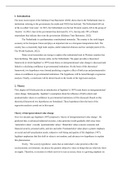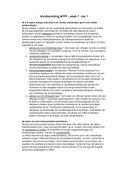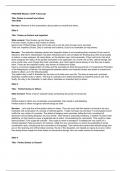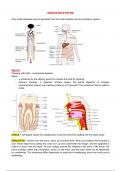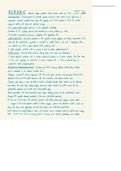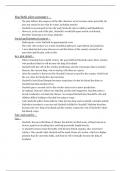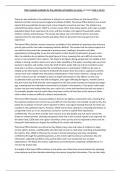Chapter 1: Introduction to supply chain management
1.1 What starts a supply chain?
Firstly, the flow of materials. They
range from raw materials, to work in
progress, to finished goods.
Secondly, the flow of information. For
example order information or dispatch
advise.
There are also reverse flows in the
form of:
-Goods (defect or obsolete products)
-Information (customer feedback)
-Packaging materials (outer cartons)
-Transportation equipment (pallets or containers)
-Funds (money that flows back into the supply chain)
The figure above shows 2 forces in the chain of goods:
1. Product supply
2. Customer demand
A customer demand driven supply chain is when the customer can place an order for their
products (often customized products).
Products that are produced on a product supply (commodities) basis, means that the supply
chain starts supplying before you come into the store.
The degree of customization dictates how much and in which format the supplying company
holds inventory.
1.2 A functional view of Supply Chain Management
The supply chain can be broken down into functional processes.
This is the Supply Chain Operations
Reference (SCOR) model.
Questions such as: ‘’How many are
we going to sell?’’ and ‘’When and
where are we going to sell them?’’
are all part of the plan process,
where demand and supply are
balanced to meet sourcing,
production and delivery needs.
The next step is to find suppliers in order to start the production process (carton, raw
materials, transport, warehousing). This source function is called purchasing or
,procurement, and it describes the process of buying goods or services to meet planned or
actual demand.
Once demand and supply are planned and materials are sourced, the actual manufacturing
can start. Thus ‘’make’’ in the model above describes all processes that transform your raw
materials into the finished products with the aim to meet customer demand.
After manufacturing, the products are ready for distribution or delivery. Under the deliver
function, all supply chain processes are included that provide finished goods to customers.
The last process is return. Returns can occur for quality reasons, for recycling or for post-
delivery customer support. All these functional processes take place in every stage of the
supply chain.
1.3 Supply Chain Players
In a simple format, a supply chain consists of 3 players: 1. The company (producer), 2. The
supplier, and 3. The customer of that company.
In an extended version there are 6 players:
On the upstream side (towards supply), there is a suppliers supplier (or the ultimate
supplier) on the beginning of the SC.
At the downside stream (towards demand), there is the customer’s customer (or the end
customer) at the end of the SC.
Customers in supply chains can be distributors (=companies that take inventory in bulk from
manufacturers and deliver an assortment of related product lines to customers),
wholesalers (= they buy from distributors or manufacturers directly. They often specialise)
and retailers (= they stock products in smaller quantities and sell them to the general
public).
Finally, there are entire categories of companies that are service providers to other players
in the supply chain. These perform services such as: Transportation, warehousing, finance,
market research, new product design, information communication and technology.
1.4 Supply Chain Dynamics
Ideally, SC’s react to changes in the environment. The task of the SC’s players is to balance
the rate of product supply in accordance with the rate of customer demand. External
influences can change the equilibrium. The challenge in supply chain management is to
balance the level of inventory while maintaining a high level of service.
, Chapter 2: Guide to plan in Supply Chain Management
2.1 Inventory and Supply Chains
The term inventory can be defined as the quantity of goods that is available on hand or in
stock. There are 3 main formats of inventory:
1. Raw material
2. Work in progress
3. Finished goods
Why hold inventory?
-To protect against uncertainties (which can be caused by variation in demand or by
restrictions in supply).
-Cost reduction (when stock is held close to the customer to minimize transport costs to
customers).
-Protect against quality defects (so that customers do not have to wait for a new product).
-Stabilise manufacturing (when all of a sudden demand is high, there is product in stock
instead of having to manufacture lots of goods at once).
-Anticipation stock (demand driven, f.e. a pre-launch stock).
To summarize: we hold inventory to balance supply and demand.
2.1.1 Different types of Inventory
-Cycle or replenishment stock: This stock keeps the supply chain moving. It is necessary to
meet the daily demand.
-Safety stock: This stock buffers against forecast error and the supplier’s unreliability.
-In-transit stock: The process of being transported to a stocking or delivery point.
-Seasonal stock: Built up in advance to meet increased sales during a particular time of the
year.
-Promotional stock: Feeds into marketing campaigns and advertising.
-Speculative stock: Is held to protect against price increases or periods of limited availability.
-Dead or obsolete stock: No longer usable or saleable in the market.
2.1.2 Cycle stock
(Average stock= order Quantity/2) (average cycle stock = as*p)
2.1.3 Safety stock
There are two parts in the safety stock calculation:
(1) Safety stock supply that covers unplanned production and delivery delays
(2) Safety stock demand that covers unplanned changes in demand
The standard deviation of demand (or forecast error) can be defined as the deviation of the
actual realized demand quantity from the forecasted quantity.
1.1 What starts a supply chain?
Firstly, the flow of materials. They
range from raw materials, to work in
progress, to finished goods.
Secondly, the flow of information. For
example order information or dispatch
advise.
There are also reverse flows in the
form of:
-Goods (defect or obsolete products)
-Information (customer feedback)
-Packaging materials (outer cartons)
-Transportation equipment (pallets or containers)
-Funds (money that flows back into the supply chain)
The figure above shows 2 forces in the chain of goods:
1. Product supply
2. Customer demand
A customer demand driven supply chain is when the customer can place an order for their
products (often customized products).
Products that are produced on a product supply (commodities) basis, means that the supply
chain starts supplying before you come into the store.
The degree of customization dictates how much and in which format the supplying company
holds inventory.
1.2 A functional view of Supply Chain Management
The supply chain can be broken down into functional processes.
This is the Supply Chain Operations
Reference (SCOR) model.
Questions such as: ‘’How many are
we going to sell?’’ and ‘’When and
where are we going to sell them?’’
are all part of the plan process,
where demand and supply are
balanced to meet sourcing,
production and delivery needs.
The next step is to find suppliers in order to start the production process (carton, raw
materials, transport, warehousing). This source function is called purchasing or
,procurement, and it describes the process of buying goods or services to meet planned or
actual demand.
Once demand and supply are planned and materials are sourced, the actual manufacturing
can start. Thus ‘’make’’ in the model above describes all processes that transform your raw
materials into the finished products with the aim to meet customer demand.
After manufacturing, the products are ready for distribution or delivery. Under the deliver
function, all supply chain processes are included that provide finished goods to customers.
The last process is return. Returns can occur for quality reasons, for recycling or for post-
delivery customer support. All these functional processes take place in every stage of the
supply chain.
1.3 Supply Chain Players
In a simple format, a supply chain consists of 3 players: 1. The company (producer), 2. The
supplier, and 3. The customer of that company.
In an extended version there are 6 players:
On the upstream side (towards supply), there is a suppliers supplier (or the ultimate
supplier) on the beginning of the SC.
At the downside stream (towards demand), there is the customer’s customer (or the end
customer) at the end of the SC.
Customers in supply chains can be distributors (=companies that take inventory in bulk from
manufacturers and deliver an assortment of related product lines to customers),
wholesalers (= they buy from distributors or manufacturers directly. They often specialise)
and retailers (= they stock products in smaller quantities and sell them to the general
public).
Finally, there are entire categories of companies that are service providers to other players
in the supply chain. These perform services such as: Transportation, warehousing, finance,
market research, new product design, information communication and technology.
1.4 Supply Chain Dynamics
Ideally, SC’s react to changes in the environment. The task of the SC’s players is to balance
the rate of product supply in accordance with the rate of customer demand. External
influences can change the equilibrium. The challenge in supply chain management is to
balance the level of inventory while maintaining a high level of service.
, Chapter 2: Guide to plan in Supply Chain Management
2.1 Inventory and Supply Chains
The term inventory can be defined as the quantity of goods that is available on hand or in
stock. There are 3 main formats of inventory:
1. Raw material
2. Work in progress
3. Finished goods
Why hold inventory?
-To protect against uncertainties (which can be caused by variation in demand or by
restrictions in supply).
-Cost reduction (when stock is held close to the customer to minimize transport costs to
customers).
-Protect against quality defects (so that customers do not have to wait for a new product).
-Stabilise manufacturing (when all of a sudden demand is high, there is product in stock
instead of having to manufacture lots of goods at once).
-Anticipation stock (demand driven, f.e. a pre-launch stock).
To summarize: we hold inventory to balance supply and demand.
2.1.1 Different types of Inventory
-Cycle or replenishment stock: This stock keeps the supply chain moving. It is necessary to
meet the daily demand.
-Safety stock: This stock buffers against forecast error and the supplier’s unreliability.
-In-transit stock: The process of being transported to a stocking or delivery point.
-Seasonal stock: Built up in advance to meet increased sales during a particular time of the
year.
-Promotional stock: Feeds into marketing campaigns and advertising.
-Speculative stock: Is held to protect against price increases or periods of limited availability.
-Dead or obsolete stock: No longer usable or saleable in the market.
2.1.2 Cycle stock
(Average stock= order Quantity/2) (average cycle stock = as*p)
2.1.3 Safety stock
There are two parts in the safety stock calculation:
(1) Safety stock supply that covers unplanned production and delivery delays
(2) Safety stock demand that covers unplanned changes in demand
The standard deviation of demand (or forecast error) can be defined as the deviation of the
actual realized demand quantity from the forecasted quantity.


